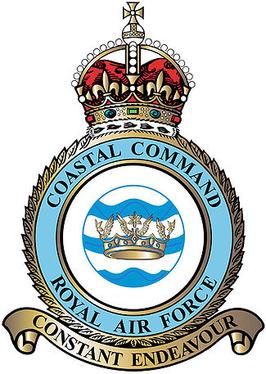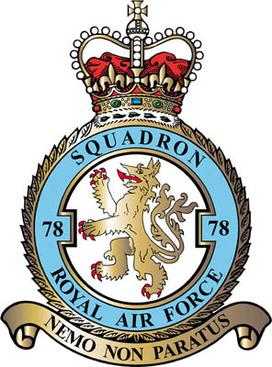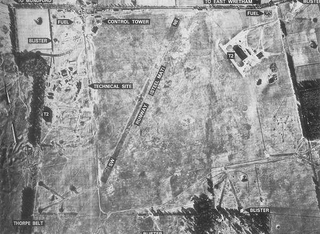
RAF Coastal Command was a formation within the Royal Air Force (RAF). It was founded in 1936, when the RAF was restructured into Fighter, Bomber and Coastal commands and played an important role during the Second World War. Maritime Aviation had been neglected in the inter-war period, due to disagreements between the Royal Navy (RN) and RAF over the ownership, roles and investment in maritime air power.

The Desert Air Force (DAF), also known chronologically as Air Headquarters Western Desert, Air Headquarters Libya, the Western Desert Air Force, and the First Tactical Air Force (1TAF), was an Allied tactical air force created from No. 204 Group RAF under RAF Middle East Command in North Africa in 1941 to provide close air support to the British Eighth Army against Axis forces. Throughout the Second World War, the DAF was made up of squadrons from the Royal Air Force (RAF), the South African Air Force (SAAF), the Royal Australian Air Force (RAAF), the United States Army Air Forces (USAAF) and other Allied air forces.

RAF Fighter Command was one of the commands of the Royal Air Force. It was formed in 1936 to allow more specialised control of fighter aircraft. It served throughout the Second World War. It earned near-immortal fame during the Battle of Britain in 1940, when the Few held off the Luftwaffe attack on Britain. The Command continued until 17 November 1943, when it was disbanded and the RAF fighter force was split into two categories; defence and attack. The defensive force became Air Defence of Great Britain (ADGB) and the offensive force became the RAF Second Tactical Air Force. Air Defence of Great Britain was renamed back to Fighter Command in October 1944 and continued to provide defensive patrols around Great Britain. It was disbanded for the second time in 1968, when it was subsumed into the new Strike Command.

No. 78 Squadron of the Royal Air Force, is the squadron number plate of RAF (Unit) Swanwick based at London Area Control Centre, Swanwick, Hampshire. The squadron was allocated the role in early 2021.

No. 14 Squadron of the Royal Air Force currently operates the Beechcraft Shadow R1 in the Intelligence, surveillance, target acquisition, and reconnaissance (ISTAR) role from RAF Waddington.

The Syria–Lebanon campaign, also known as Operation Exporter, was the invasion of Syria and Lebanon in June and July 1941 by British Empire forces, during the Second World War.
No. 37 Squadron was a Royal Air Force squadron of the First and Second World Wars.

No. 301 Polish Bomber Squadron "Land of Pomerania" was a Polish World War II bomber (1940-1943) and special duties squadron (1944-1946), belonging to Polish Air Forces in Great Britain. It fought alongside the Royal Air Force and operated from RAF airfields in the United Kingdom and Italy.

No. 304 Polish Bomber Squadron was a Polish World War II bomber unit. It fought alongside the Royal Air Force under their operational Command and operated from airfields in the United Kingdom, serving from April 1941 as a bomber unit in RAF Bomber Command, from May 1942 as an anti-submarine unit in RAF Coastal Command and from June 1945 as a transport unit in RAF Transport Command.

Royal Air Force East Wretham or more simply RAF East Wretham is a former Royal Air Force station located 6 miles (9.7 km) northeast of Thetford, Norfolk, England.
No. 52 Squadron was a Royal Air Force squadron that saw service in both World War I and World War II.

No. 500 Squadron AAF was a Royal Air Force flying squadron. It was initially formed in 1931 as a Special Reserve squadron and in 1936 became part of the Auxiliary Air Force, at this time based at Manston and Detling.
818 Naval Air Squadron was a Royal Navy Fleet Air Arm carrier-based squadron formed in August 1939. It served on a number of the Navy's aircraft carriers during the Second World War, serving in most of the theatres of the war, before decommissioning at the end of the war.

Royal Air Force Thorney Island, or more simply RAF Thorney Island, is a former Royal Air Force station located on Thorney Island, West Sussex, England, 6.6 miles (10.6 km) west of Chichester and 7.1 miles (11.4 km) east of Portsmouth, Hampshire.
Number 88 Squadron was an aircraft squadron of the Royal Air Force. It was formed at Gosport, Hampshire in July 1917 as a Royal Flying Corps (RFC) squadron.

No. 223 Squadron RAF was a squadron of the Royal Air Force. Originally formed as part of the Royal Naval Air Service (RNAS), the Squadron flew in both World Wars.
No. 248 Squadron was a squadron of the Royal Air Force, active immediately after World War I, and again during World War II.
Coastal Command was a formation within the Royal Air Force (RAF). Founded in 1936, it was to act as the RAF maritime arm, after the Fleet Air Arm became part of the Royal Navy in 1937. Naval aviation was neglected in the inter-war period, 1919–1939, and as a consequence the service did not receive the resources it needed to develop properly or efficiently. This continued until the outbreak of the Second World War, during which it came to prominence. Owing to the Air Ministry's concentration on Fighter Command and Bomber Command, Coastal Command was often referred to as the "Cinderella Service", a phrase first used by the First Lord of the Admiralty at the time A. V. Alexander.
No. 114 Squadron was a squadron of the British Royal Air Force. It was first formed in India during the First World War, serving as a light bomber squadron during the Second World War and as a transport squadron post-war. It was last disbanded in 1971.











